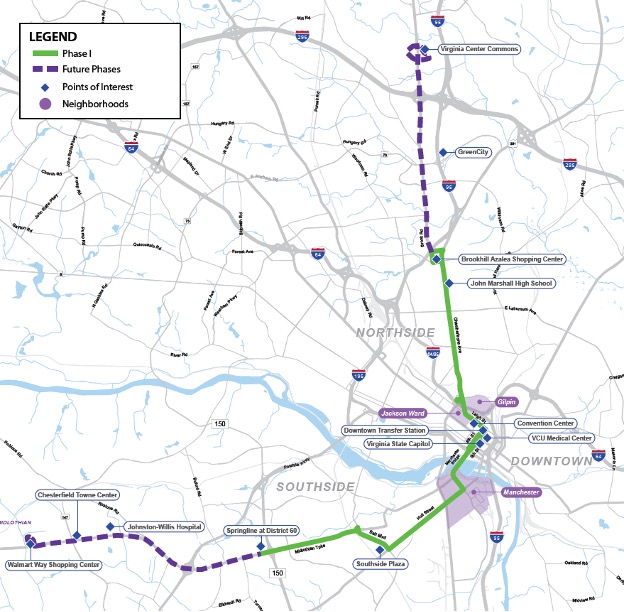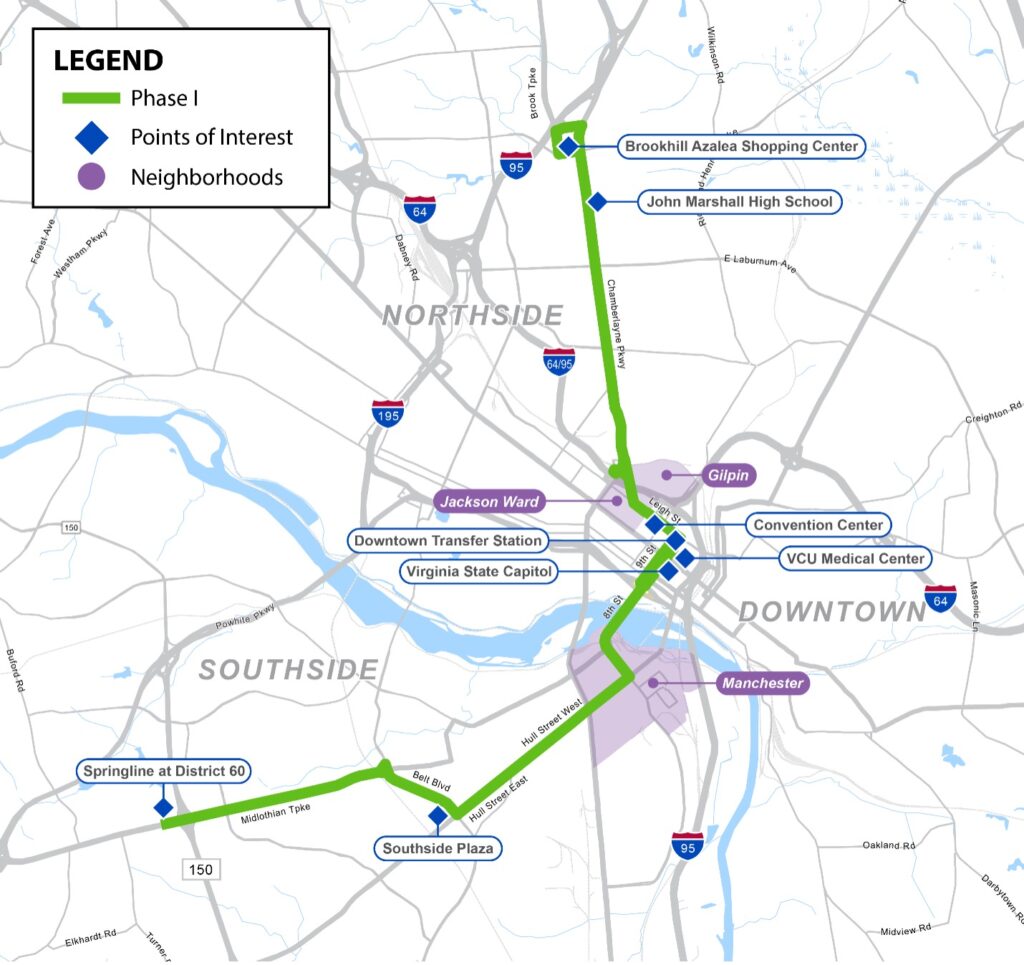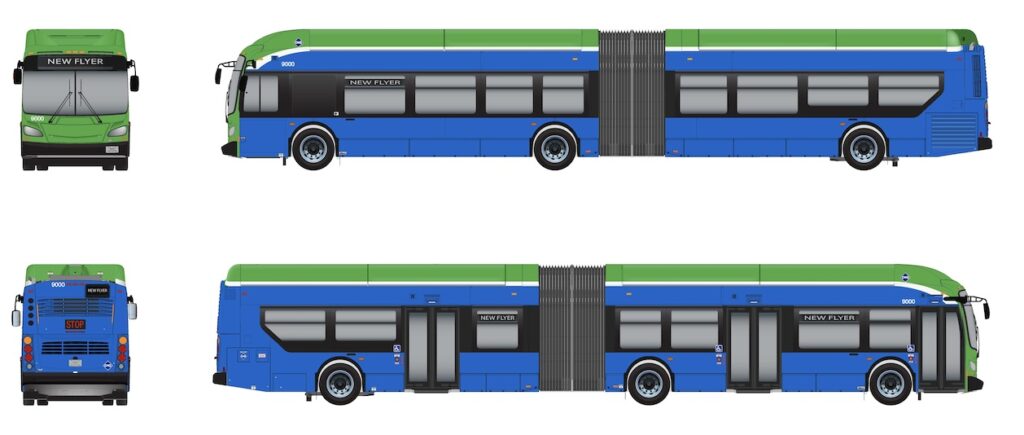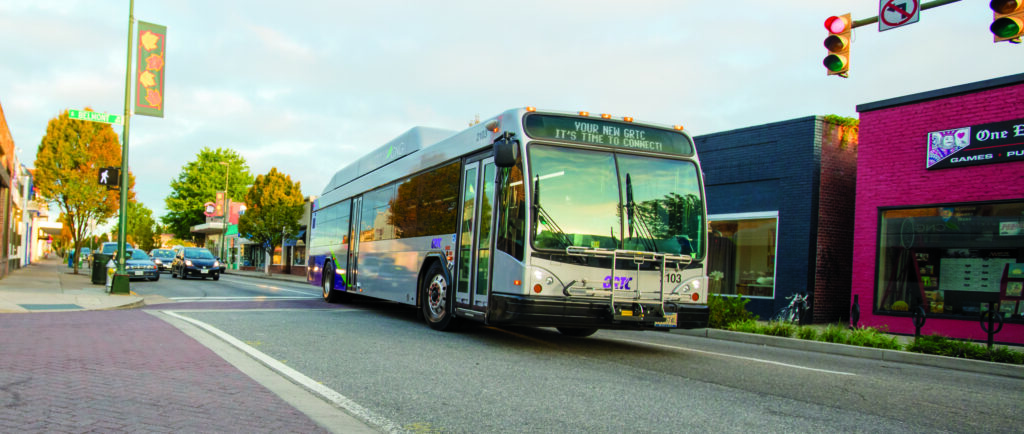
GRTC is working to expand access to public transportation across the Richmond region.
Explore our current projects:
-
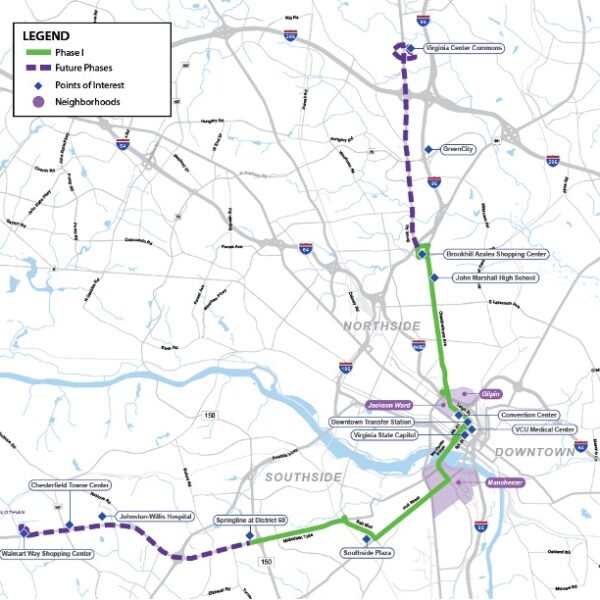
North-South Pulse Expansion
-
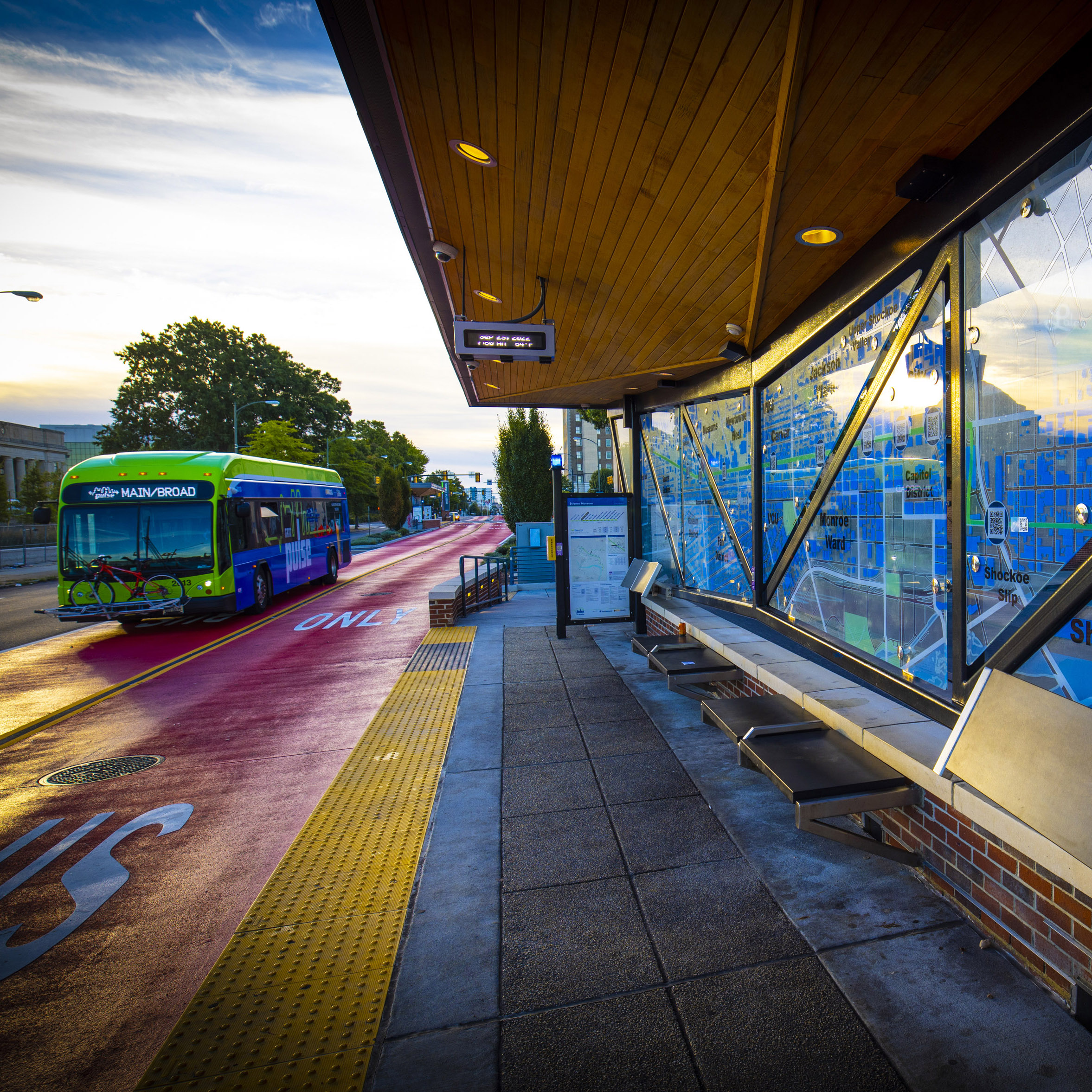
Pulse Station Modification
-
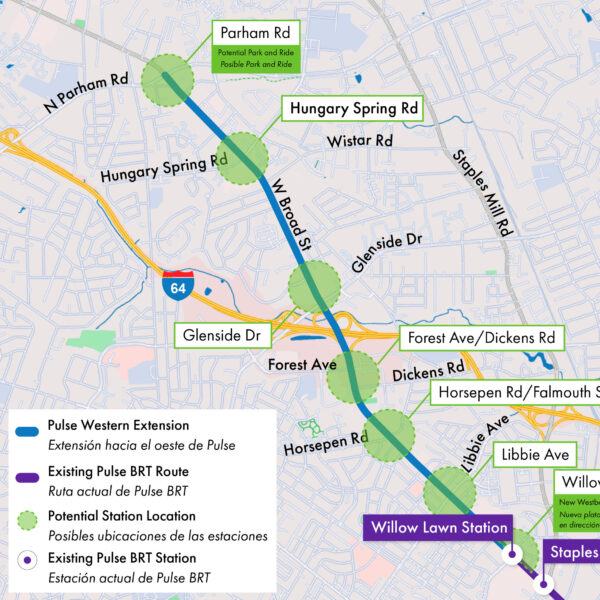
Pulse Western Extension
-
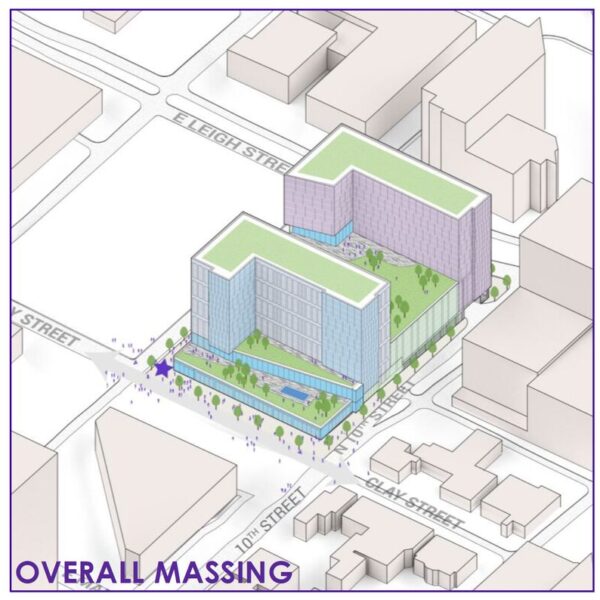
Permanent Transfer Downtown Station
-
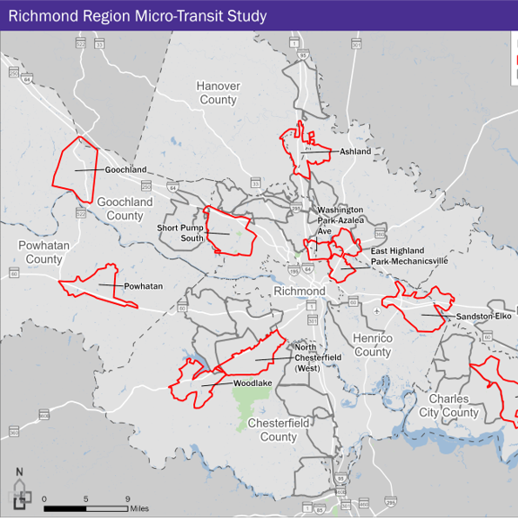
Richmond Regional Microtransit
-
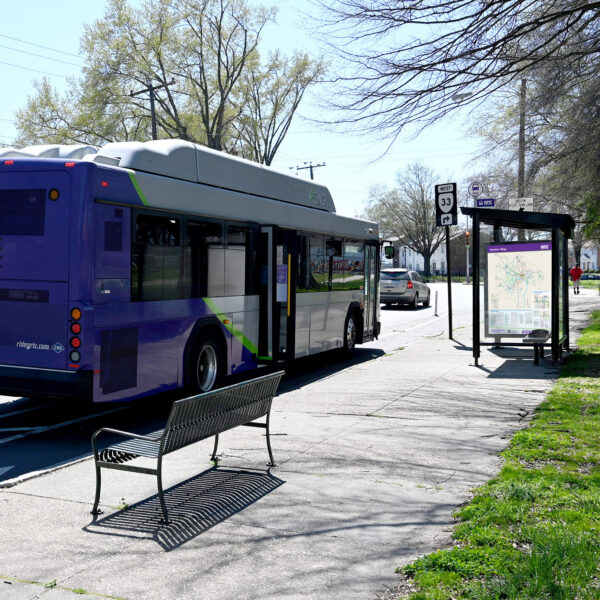
Shelters and Benches
Have you heard the news? GRTC’s Pulse BRT is a success, and riders want more efficient, convenient, and reliable connections to get you where you need to go! To accommodate people on the move, we’re excited to announce the next phase of the GRTC Pulse North-South Bus Rapid Transit (BRT) – GRTC’s commitment to help keep our region moving. The North-South BRT will connect Northside and Southside to the existing GRTC Pulse BRT and beyond, making it easier and safer for everyone to get around with bus service that is more reliable, convenient, and faster for all of us.
GRTC Pulse North-South BRT will connect more of the region, including Chamberlayne Avenue, Leigh Street, 8th Street, 9th Street, Commerce Road, Hull Street, Belt Boulevard, and Midlothian Turnpike. Adding a North-South BRT to the existing GRTC Pulse system will support regional growth and help provide equitable access to jobs, education, and community services.
Project Map
Project Details
In Fall 2023, GRTC completed the GRTC Pulse North-South Bus Rapid Transit (BRT) Study to determine a locally preferred alternative for a North-South rapid bus route. The study paired public input with analysis of demographics, employment, equity, multimodal connectivity, and existing transit service. GRTC selected a preferred corridor alignment for further design and environmental review.
This project picks up where the 2023 study left off. GRTC Pulse North-South BRT will be constructed in phases. This project will advance Phase I of the locally preferred alternative through preliminary design and the federally required environmental evaluation process. It will also advance preliminary planning of the segments identified as future phases of the alignment. Phase I of the project will comprise at least 50% dedicated bus lanes and numerous BRT stations (locations to be determined) along the corridor. When this project concludes, Phase I will be eligible to compete for federal funding for detailed design and construction.
Phase I Project Map
What’s Happening?
Spring 2025 community engagement for the GRTC Pulse North-South BRT Project is underway. During the Fall 2024 engagement process, we asked for your thoughts on potential designs for the project corridor. Since that time, we’ve made updates to the conceptual design, based on public feedback or additional analysis and considerations. You can view detailed descriptions of the changes by reviewing this document: GRTC Pulse North-South BRT Conceptual Design Updates
During Spring 2025 engagement, we will present updates to the conceptual design, based on additional technical analysis and feedback from the public collected in Fall 2024. There are plenty of opportunities for you to get involved:
- Pop-up event—Liberation Church on March 20, 2025, from 1:00pm to 4:00pm
- In-person public meeting—Main Street Station on March 25, 2025, from 5:00pm to 7:00pm
- A virtual meeting—via Zoom on March 27, 2025, from 12:00pm to 1:00pm
- Click here to register!
- An online survey—open from March 17, 2025, to April 18, 2025
- Click here to take the survey!
Updated Conceptual Design
To gain a detailed understanding of the updated conceptual design, feel free to review the PDFs linked below. These design concepts will be displayed as meeting boards at the in-person public meeting on March 25, 2025, at Main Street Station.
- Midlothian Turnpike
- Belt Boulevard
- Hull Street
- Commerce Road
- 8th and 9th Streets
- Leigh Street
- Chamberlayne Parkway
- Chamberlayne Avenue
- North Chamberlayne Avenue
- Azalea Avenue – Brook Road
Project Information
For more information about the project, review the PDFs of the additional informational boards that will be displayed at the in-person public meeting on March 25, 2025, at Main Street Station.
- Parking Inventory and Occupancy
- Project Information
- Project Map
- Traffic Exhibit
- Tree Exhibit
- Typical Sections
- Typical Station Concept
Why Participate?
As the Richmond region grows, our transit system must keep up. GRTC Pulse North-South BRT Project will help people get to jobs, schools, grocery stores, doctors’ offices, and other destinations. By participating in the process, you’re helping to create a transit system that works for you and for your community by helping our region to plan for its future.
Get Involved!
Exciting times are ahead as we make progress on the North-South BRT Pulse project! Your involvement is key as we work to develop a more connected and accessible transportation system. Here are some opportunities for you to join us at various engagement events to share your ideas, ask questions, and help shape the future of our community’s transit.
Engagement Opportunities:
Online Survey with Interactive Map and Survey
- March 17th, 2025 – April 18th, 2025
- Click here to take the survey!
- Dive into the proposed plans, visualize your suggestions, and provide valuable feedback online.
Attend the Pop-up Event:
- Liberation Church:
- March 20th, 2025, from 1:00 PM to 4:00 PM
Meet with the technical experts at the In-Person Public Meeting:
- March 25th, 2025, from 5:00 PM to 7:00 PM
- Meet the project team, ask questions, and share your feedback face-to-face.
Join us online to discuss the project and provide your input from the comfort of your home at a Virtual Public Meeting:
- March 27th, 2025, from 12:00 PM to 1:00 PM
- Click here to register!
Don’t miss this chance to make a difference! Let’s come together to create a Bus Rapid Transit system that meets the needs of our community.
The existing 26 Pulse stations are designed to carry the Pulse’s originally projected 3500 daily passengers. Today, the Pulse moves more than 6100 daily passengers on vehicles that are increasingly crowded and running at maximum capacity. The solution is to acquire new 60′ articulated buses, which feature more passenger loading space, new on-board amenities, and a third door for faster and easier boarding and alighting. In order to accommodate the third door and improve operational efficiency, GRTC is working to remove the brick knee wall that borders the platform to allow for the new buses to approach the stations and fit all three doors onto the platform.
What are we doing?
We are making minor modifications to existing GRTC Pulse stations to enhance capacity, improve operations, and prepare for articulated buses. The project involves the removal of part of the “knee wall” that borders the station area and the replacement of tiling and the rubber guide rail used by buses to achieve level boarding at stations. Construction will require the temporary closure of stations and relocation of service to the closest available local stop.
Why does this need to happen?
Pulse ridership has already greatly surpassed expectations, and as the region and system continue to grow, we’re expanding our fleet to match. Over time, we’ll replace the existing 40′ bus fleet with new New Flyer 60′ buses. These new buses will both expand capacity and improve operations. They can carry up to 50 additional people per trip, and are equipped with a third door for faster boarding and quicker stops. Check out the most recent renderings of our new buses below!
How long will it take?
We anticipate construction lasting for 260 working days. Crews will be working during daytime hours, and while there will be some lane reductions for safety, we’ll be working to maintain the flow of traffic along Broad and Main Street – as well as continuing to operate service throughout the project. Individual station construction timelines will depend on the location, but closures will be communicated to the public.
Demand for transit service along W Broad Street is continuing to increase, and GRTC and Henrico County are working to meet it with a four-mile expansion of the existing Pulse west from Willow Lawn to Parham Road. This first extension of the Pulse will add eight new stations and additional dedicated lanes, expanding access to rapid transit deeper into Henrico County and adding key elements that do not currently exist in the Pulse system, such as a dedicated park and ride location. Pulse Western Extension is currently in Phase 2 of study, which includes preliminary design elements and National Environmental Policy Act work. Click here to learn more.
Project Map
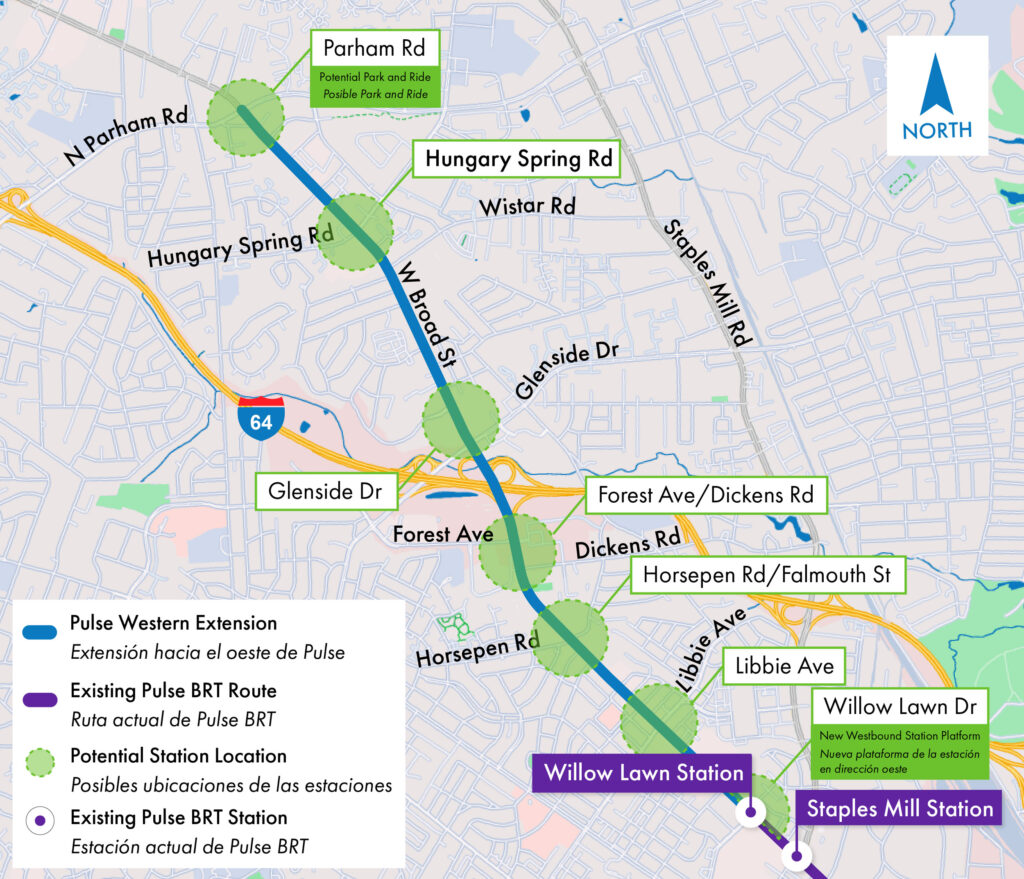
In the fall of 2023, GRTC retained consultant support to study a permanent transfer facility in Downtown Richmond. The team, which is managed by HR & A and includes the support of VHB and Design Collective, has been working to identify the location, best potential amenities, and development potential for a public-private partnership to create a permanent 10-bay transfer facility with mixed-use housing and commercial opportunities.
The following documents were provided to GRTC throughout the study and are presented to the public below:
Permanent Downtown Transfer Hub – Consultant Introduction
Permanent Downtown Transfer Hub – Public Meeting Slide Deck – January 2024
Permanent Downtown Transfer Hub – Second Public Meeting Slide Deck – March 2024
Permanent Downtown Transfer Hub – Final Consultant Report – May 2024
Permanent Downtown Transfer Hub – Project Appendix A – Land Use & Zoning Memo
Permanent Downtown Transfer Hub – Project Appendix B – Transit Technical Memo
Permanent Downtown Transfer Hub – Project Appendix C – Market Scan
Permanent Downtown Transfer Hub – Project Appendix D – Site Selection Assessment
Permanent Downtown Transfer Hub – Project Appendix E – Final Design Package
Feedback?
The creation of the Central Virginia Transportation Authority (CVTA) by the 2020 General Assembly established new funds for priority transportation investments in the Richmond Region.
The two main sources of revenue are regional sales and use tax (0.7%) and wholesale gas and diesel tax (7.6 cents and 7.7 cents). The CVTA funds are allocated in three ways – 15% to GRTC, 50% to each participating locality proportionally, and 35% for regional projects. GRTC is required to develop a Regional Public Transportation Plan that identifies how GRTC plans to spend the 15% allocation. A micro-transit study was identified as a regional priority during the development of the FY2022 plan.
The microtransit study identified recommendations for a pilot program that launched in fall of 2023 – GRTC’s LINK Microtransit.
What is Microtransit?
Microtransit is on-demand, curb-to-curb public transportation that provides transit service in areas that might not support traditional fixed route bus demand.
Microtransit Pilot Program Overview
The Greater Richmond Transit Company (GRTC), partnered with consultant Michael Baker International, exploring the demand, need, potential, and feasibility for microtransit services in the Greater Richmond Region. The Greater Richmond Region includes the jurisdictions of Ashland, Charles City, Chesterfield, Goochland, Hanover Henrico, New Kent, Powhatan, and the City of Richmond.
GRTC provides a range of Essential Transit Infrastructure (ETI) at stops including, but not limited to, benches, trash cans, and shelters. ETI elements are intended to provide comfort, convenience, accessibility, safety, and dignity to riders. This document is meant to outline implementation goals and strategies for the installation of ETI at GRTC local stops and transit facilities. This is one of several GRTC strategic initiatives planned that aim to address the various impediments to transit access and ultimately inequities. GRTC champions social and economic mobility by prioritizing connecting people to essential human services and needs. With proper operational and capital investment, transit is a factor that can improve overall quality of life.
GRTC is using a scoring system that considers usage and equity to determine which stops qualify for improvements.
The attached spreadsheet shows the ETI Plan Installation preliminary installation goals, considering only existing ETI and rubric thresholds.
Consider this list as the starting point of the Aspirational Scenario approved by our Board of Directors (PDF) (Excel).
Next steps are:
- GRTC staff is performing site visits to evaluate on-the-ground conditions and the feasibility of preliminary installation goals
- GRTC staff is coordinating with our local jurisdictional partners to see where opportunities exist to collaborate on grant applications and in-progress construction projects. Ongoing projects and funding sources will inform both installation goals and timelines.
GRTC staff will wrap up this second level of analysis by early spring and publish here an updated list of installation goals by stop.
Stops recommended for ETI installation in this updated list will move on to the next steps: conceptual approval by the jurisdictions and engineering.


